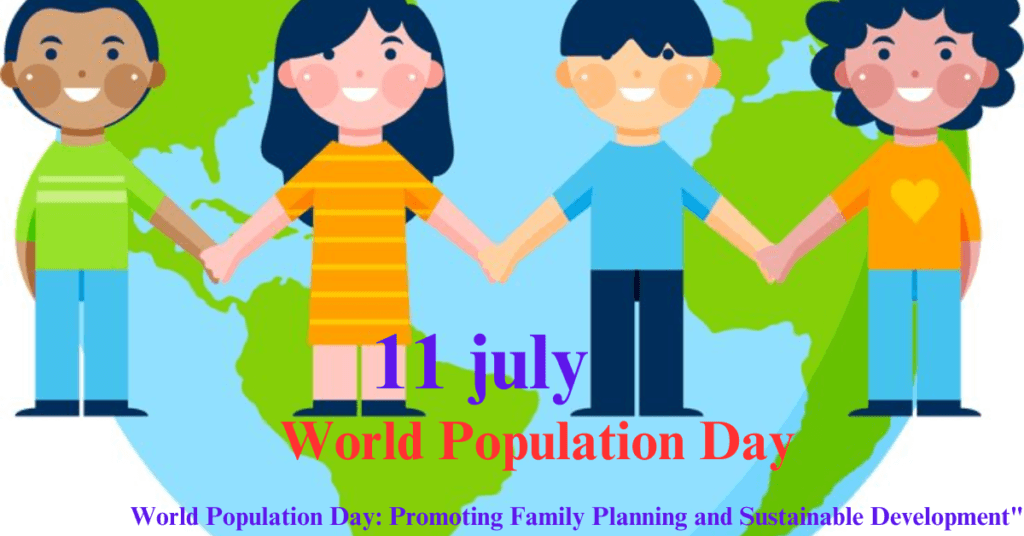
Table of Contents
World Population Day: Promoting Family Planning and Sustainable Development”

Vishva Janshankhiya Diwas, or World Population Day, is observed annually on July 11th to raise awareness about global population issues. Setup by the United Nations in 1989, this day highlights the importance of population control and its impact on development and the environment. The observance of this day underscores the challenges posed by a growing global population, such as resource depletion, environmental degradation, and socioeconomic inequalities. It also emphasizes the need for comprehensive strategies to address these issues through sustainable development, gender equality, and family planning.
Historical Background
The idea of World Population Day was conceived in the context of growing concerns over the rapid increase in global population. The milestone that triggered this initiative was July 11, 1987, which was designated as the Day of Five Billion when the world’s population was estimated to have reached five billion people. This significant event highlighted the urgent need to address the implications of population growth on economic development, resource management, and environmental sustainability.
In response to these concerns, the United Nations Development Programme (UNDP) established World Population Day in 1989. The objective was to focus global attention on the urgency and importance of population issues, particularly in the context of family planning, gender equality, poverty alleviation, and sustainable development.
Population Growth Trends
Over the past few decades, the world has witnessed unprecedented population growth. The global population reached one billion in 1804, two billion in 1927, three billion in 1960, and four billion in 1974. By 1987, it had grown to five billion, and today, it stands at over 7.9 billion. This rapid growth has profound implications for various aspects of human life and the planet.
- Resource Depletion: As the population grows, the demand for natural resources such as water, land, and energy increases. This often leads to the over-exploitation of these resources, resulting in environmental degradation, loss of biodiversity, and depletion of essential natural reserves.
- Environmental Impact: Increased human activity contributes to environmental issues such as deforestation, pollution, and climate change. The strain on ecosystems and natural habitats threatens wildlife and disrupts ecological balance.
- Economic and Social Challenges: Population growth can exacerbate poverty, unemployment, and inequality. It puts pressure on infrastructure, healthcare, and education systems, making it challenging to provide basic services and improve the quality of life for all.
Family Planning and Reproductive Health
One of the central themes of World Population Day is the importance of family planning and reproductive health. Access to family planning services empowers individuals and couples to make informed decisions about the number and spacing of their children. This, in turn, contributes to improved maternal and child health, gender equality, and economic development.
- Reducing Unintended Pregnancies: Family planning helps prevent unintended pregnancies, reducing the risk of maternal and infant mortality. It also enables women to pursue education and employment opportunities, contributing to their empowerment and economic independence.
- Promoting Gender Equality: Access to reproductive health services is crucial for achieving gender equality. When women have control over their reproductive choices, they can participate more fully in social, economic, and political life.
- Supporting Sustainable Development: Family planning is integral to sustainable development. By helping to stabilize population growth, it alleviates pressure on natural resources and supports efforts to address climate change and environmental degradation.
Population Policies and Programs
Governments and organizations worldwide have implemented various policies and programs to address population issues. These initiatives focus on promoting family planning, improving reproductive health, and supporting sustainable development.
- Family Planning Programs: Many countries have established family planning programs to provide access to contraceptive methods, reproductive health services, and education. These programs aim to reduce unintended pregnancies, improve maternal and child health, and promote gender equality.
- Education and Awareness Campaigns: Public awareness campaigns play a crucial role in educating communities about the importance of family planning and reproductive health. These campaigns use various media channels to reach a wide audience and promote informed decision-making.
- Legislative and Policy Frameworks: Governments have enacted laws and policies to support reproductive health and rights. These frameworks ensure that individuals have access to family planning services, protect their rights, and promote gender equality.
Challenges and Opportunities
Addressing global population issues presents both challenges and opportunities. While population growth poses significant challenges, it also offers opportunities for innovation, collaboration, and sustainable development.
- Overcoming Barriers to Access: In many parts of the world, access to family planning services and reproductive health care remains limited. Cultural, economic, and logistical barriers prevent individuals from obtaining the services they need. Addressing these barriers requires comprehensive strategies, including community engagement, education, and infrastructure development.
- Harnessing Technology and Innovation: Advances in technology and innovation offer new opportunities to address population issues. Digital platforms, mobile health applications, and telemedicine can expand access to reproductive health services, particularly in remote and underserved areas.
- Fostering Collaboration and Partnerships: Addressing population issues requires collaboration among governments, organizations, and communities. Partnerships at the local, national, and international levels can pool resources, share knowledge, and implement effective strategies.
Case Studies
Several countries have implemented successful population policies and programs that offer valuable lessons for addressing global population issues.
- Bangladesh: Bangladesh has made significant progress in reducing its fertility rate through comprehensive family planning programs. The country has invested in community-based services, education, and awareness campaigns to promote family planning and reproductive health. As a result, the fertility rate has declined from 6.3 children per woman in the 1970s to 2.1 children per woman today.
- Iran: Iran’s family planning program is another success story. In the 1980s, the government implemented a comprehensive program that included access to contraceptives, education, and economic incentives for smaller families. The program successfully reduced the fertility rate from 6.5 children per woman in the mid-1980s to 2.0 children per woman by the early 2000s.
- Rwanda: Rwanda has made remarkable progress in improving reproductive health and family planning services. The country has focused on expanding access to services, particularly in rural areas, and promoting gender equality. These efforts have resulted in a significant decline in the fertility rate and improved maternal and child health outcomes.
Sustainable Development Goals (SDGs)
World Population Day aligns with several Sustainable Development Goals (SDGs) adopted by the United Nations in 2015. These goals provide a comprehensive framework for addressing global challenges, including population issues.
- SDG 3: Good Health and Well-being: This goal aims to ensure healthy lives and promote well-being for all at all ages. It includes targets related to reducing maternal and child mortality, improving reproductive health, and ensuring access to family planning services.
- SDG 5: Gender Equality: Achieving gender equality and empowering all women and girls is a key goal that intersects with population issues. It includes targets related to eliminating gender-based violence, ensuring equal access to education and economic opportunities, and promoting reproductive rights.
- SDG 13: Climate Action: Addressing climate change is closely linked to population dynamics. Efforts to stabilize population growth through family planning and reproductive health services can contribute to mitigating the impacts of climate change and promoting environmental sustainability.
The Role of International Organizations
International organizations play a crucial role in addressing global population issues. These organizations provide funding, technical assistance, and advocacy to support population policies and programs.
- United Nations Population Fund (UNFPA): The UNFPA is a key agency that promotes reproductive health, family planning, and gender equality. It works with governments and partners to implement programs, conduct research, and advocate for policies that address population issues.
- World Health Organization (WHO): The WHO provides technical support and guidance on reproductive health and family planning. It develops evidence-based guidelines, conducts research, and supports capacity-building efforts in countries.
- Non-Governmental Organizations (NGOs): NGOs play a vital role in delivering services, raising awareness, and advocating for policy change. Organizations such as Planned Parenthood, Marie Stopes International, and the Population Council work at the grassroots level to improve access to reproductive health services and promote family planning.
Conclusion
Vishva Janshankhiya Diwas, or World Population Day, serves as a reminder of the pressing need to address global population issues. As the world’s population continues to grow, the challenges of resource depletion, environmental degradation, and socioeconomic inequalities become more pronounced. By promoting family planning, reproductive health, and sustainable development, we can address these challenges and improve the quality of life for all.
Efforts to address population issues must be comprehensive and inclusive, involving governments, organizations, and communities. By overcoming barriers to access, harnessing technology and innovation, and fostering collaboration, we can create a sustainable and equitable future. World Population Day is an opportunity to reflect on our progress, reaffirm our commitments, and take collective action to ensure a better future for generations to come.


